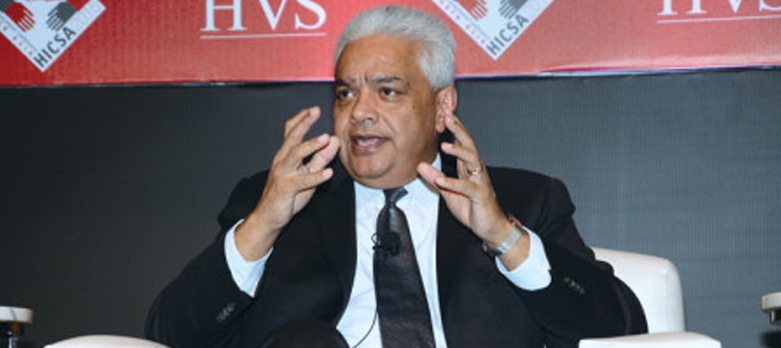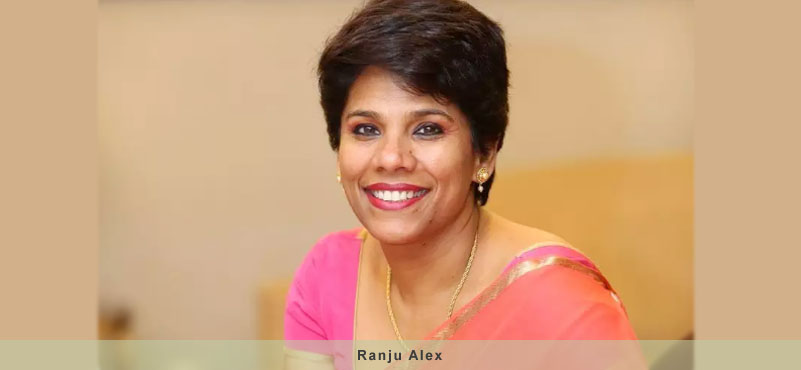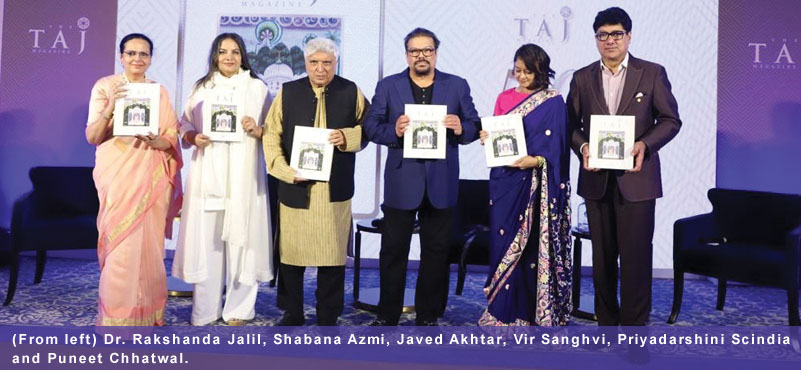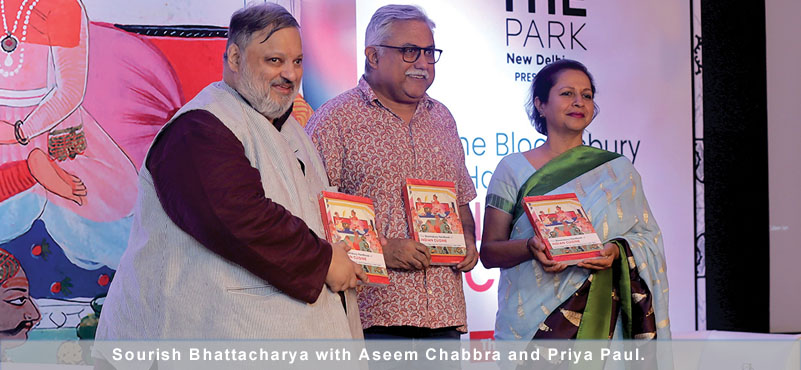Rakesh Sarna is the new head at India’s most iconic hotel brand, the Taj Group. Here in an exclusive interview, Sarna talks of building and strengthening the Taj equity across its various brands.
Please share with us about your coming back to India after all these years and what’s your personal gut to what is happening to the Indian hospitality industry as a whole.
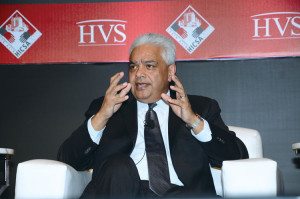 Sure, so I was gone for almost 40 years. I left as a young boy and came back after 40 plus years. I am not sure I can articulate correctly what the emotions were that lead me to come back but I am delighted to be back. I am specifically delighted because I am back as part of the Taj family. I have always felt very strongly, even as a competitor in the past that Taj holds a very special place in the hearts and minds of Indians and there is a spirit of patriotism. Being in India at this time in my life, or at this time in India’s life I think it is a very exciting time. I am not predisposed to any political party. I am full of hope. I think if you focus on the right things the results sometimes take time and people by nature are rather impatient but I remain very hopeful. If you look at the current circumstances politically and economically in the country and combine them with what’s happening globally I think we should all feel fairly positive. You know there is this old saying that economies get uplifted by the mood of the country. People start to think of what can be and get rid of the cynicism and the attitude of ‘chata hai’. I feel that people here need to ask what are they going to do for their country instead of just sitting there being arm-chair critics.
Sure, so I was gone for almost 40 years. I left as a young boy and came back after 40 plus years. I am not sure I can articulate correctly what the emotions were that lead me to come back but I am delighted to be back. I am specifically delighted because I am back as part of the Taj family. I have always felt very strongly, even as a competitor in the past that Taj holds a very special place in the hearts and minds of Indians and there is a spirit of patriotism. Being in India at this time in my life, or at this time in India’s life I think it is a very exciting time. I am not predisposed to any political party. I am full of hope. I think if you focus on the right things the results sometimes take time and people by nature are rather impatient but I remain very hopeful. If you look at the current circumstances politically and economically in the country and combine them with what’s happening globally I think we should all feel fairly positive. You know there is this old saying that economies get uplifted by the mood of the country. People start to think of what can be and get rid of the cynicism and the attitude of ‘chata hai’. I feel that people here need to ask what are they going to do for their country instead of just sitting there being arm-chair critics.
Now tell me a little more on the personal side, were you looking back to relocating to India or did this offer come your way? What came first?
No, there was no desire to get back.
So here was a compelling offer that got you back?
That’s a good way of putting it. But I think you need to elaborate a little bit. It was a compelling offer but not compelling for economic reasons but other reasons. I felt Taj is a huge brand and has values and it became a fairly difficult proposition to resist.
But in these 40 years, you kept coming to the country?
I did. I spent 35 years with Hyatt and I was quite actively engaged with India from 1997-2000 and then from 2007 to 2012. Don’t forget that India is the third most important market for Hyatt. There is a heavy focus on India and a high level of interaction.
Coming back to our more formal questions, you have taken charge at a time when the chips are down for the hospitality industry as a whole. It could be a bad time to take over, or perhaps a good time. Which way do you see it, and why?
You know I think it is a great time to be here. It is a great time to be here for any industry and I don’t think the chips were down. I think we went through an economic cycle and we will go through many more of those. India is going through a very encouraging time because you have seen a huge influx of brands in the years 2012-2014 and which has created a serious disconnect between supply and demand. India is not the only country to experience that. Shanghai and Beijing are going through some serious pains to make the supply and demand meet because that creates price elasticity. And that will come. I am very confident that what we are building in India for tomorrow is extremely good. So it is not a bad time, it is a very good time. I believe that we need to talk up the economy, we need to talk up the emotional mood of the country and demand will catch up with supply, consumer spending is at an all time high and inflation is reasonably decent. It is a great time.
You know when I say is it a good time to come to the country, when I say that the hospitality industry is facing many challenges, so is the Taj group, I presume, as is everybody else. So for you, within the Taj, what is the mood like? Where are you planning to take the group say in the short term, medium term and long term? How are you viewing the challenge in the market?
Any leader in any business today, including Taj, needs to focus on the financial and the holistic health of its organization. Taj given the economic circumstances in the country, given some very good decisions taken in the past, has got a few things to take care of. We feel very confident that those things will be taken care of. The media in this country, I am quite amused, between you and I, they talk about Man Singh and Sea Rock but tell me one country, one company or one society in this world that doesn’t have situations on its plate. Tomorrow Mansingh and Sea Rock will get resolved and there will be something else. So life goes on. I don’t see anything in Taj’s sphere today that gives me a serious heart burn. I remain very confident because the people that fill this culture are very committed and very intelligent. I have worked in the Caribbean, the Middle East, the Pacific and the Far East, and Europe and I have never seen such adoration for a brand as I see for Taj. So we are in a wonderful place. We have a few pot holes on the road to success but it doesnt worry me at all. We’ll drive around them and we will fix them.
What about the branding of the Taj Hotels, you took the systematic branding exercise 5-8 years ago and you have your luxury and Vivanta and Ginger. There is competition segment by segment – in the luxury space, the mid market, and also the budget. How do you see it evolving over the immediate future?
As of 8 or 10 years ago our brand architecture was done. I think our colleagues did a very good job. We were the first ones in India to create a house of brands. The answer is that it has been 10 years and those 10 years have seen a proliferation of brands across the industry. With the competitors arriving here from all over the world, we are relooking at our brand architecture. Also there are a lot of external pressures from our guests whose tastes have evolved and there is a new demographic cut coming into our brands. So we are reviewing these things at all times. But yes we are taking a very serious look to see where we are and see if there is need to make adjustments.
So does it mean you will have more tiers or will you reorient the brand?
We learned the hard way never to say never. So cant answer, I don’t know. But I know that we will, as a portfolio of hotels, we will not want to leave money on the table. So if we see there is a niche for a certain customer segment that we can capitalise upon, we will do so. Sitting right here at this moment, it would wrong of me to predict what we will do.
How is the Taj performing presently? How are you evaluating the performance across the various brands? Is there any brand doing better than the other?
We measure our performance from a RevPAR index in all the brands and our position in those is very encouraging. 2014-2015 has been, I believe, a very uplifting time for us, especially given the increase in supply and given that many of our global competitors have got fabulous new hotels and very strong foundation in technology and digital platform.
There are some segments where you remain supreme and probably untouchable, the Palace collection. So how do you want to capitalise on those assets? Because no one else will have a Faluknama to boast of or a Taj Jodhpur or a Taj Udaipur.
In our development strategy we are not just adding rooms. We are trying to build on the character of our brands. The palaces are a huge face of Taj and that is one segment where we will continue to look for new opportunities even if we don’t make a lot of money. We are very proud of what our ancestors have done and we are proud of our colleagues who breathe life into them.
There are other segments where Taj was traditionally very strong too, such as the MICE market. The present government is talking about the need to build convention hotels, Taj was also among the first to put up a Taj Palace Convention Centre in the new era, in New Delhi. We have not heard in recent times much emphasis on the MICE market?
The Indian market is very different from say the American market. In American cities, metros and second tier cities, you find huge conventions throughout the year. Europe you don’t find many convention cities, apart from let’s say Berlin. India the way people live, work and meet is a slightly different architecture from the US. No one is going to fly in from US or EU to have a surgeons conference in Mumbai or Delhi. But we will get to a stage where we will have large Indian companies who will hold meeting for their companies.
For that growth and evolution, there will be professional convention centres that will come up in cities. But if your question is are hotels doing enough to bring that kind of business. My answer would be that its the chicken or the egg situation. If we get the business we build more. For now, you don’t need a calculator to figure out that majority of the earning of any hotel companies come from 4-5 cities in India. So the focus is to get presence there with maximum number of rooms and social activities. In the Indian landscape, not just meetings, even weddings is huge. If you look at the yield per square foot, you get a much better yield on a wedding than on a meeting. I don’t think India is going to go with a large convention city format. I dont think we are there yet. We are going to have multiple use facilities. You have day meetings, conventions, exhibitions and of course the wedding segmentation.
We were talking about your significant presence compared to any other Indian hotel company. I had heard sometime in the past about going into cities like Bangkok or Singapore. Are there any plans that you propose for expanding the Taj footprint particularly in cities where Indians are known to be avid visitors?
Let me try to answer this question in the context of our desires and goals. We feel very strongly that we want to be globally reputable than be globally present. So while it is sexy to be in New York or Paris and Rio we are very focussed on exactly where our customer cross over is. So cities like Bangkok, Singapore, Abu Dhabi, Hong Kong and Bahrain are very important for us. In addition to having our focuses on the palaces and having hotels in the Indian metro cities, we are focussed on having a presence in South East Asia and North Asia sooner rather than later. Having said that, it is not an easy task. Shanghai for example is severely over supplied. And the availability of free hold land is complex. We want to be there but it is going to take time.
Any city, without naming it, that you hope to announce in the near future?
If the question is hope, then the answer is yes.
How do you see foreign inbound tourism coming to the country? There is a pressure on traditional generating markets, Taj group has also been a leading constituent of some of the industry bodies such as Experience India Society.
This is something I feel very strongly about. First of all given our very anaemic number of arrivals into the country, we can only get better. The question is the pace at which we will grow. So let’s take one step back and look at some of the initiatives that are currently underway which I believe will prove catalyst for improving performance. Number one, we need to clean this country up. Number two, we need to send a very strong message to the world that tourists are safe here. Number three, we need to make it easy for people to do business here. We need to fix our roads and infrastructure. Once this is done, the world wants to come to India.
How about the cost of Indian hotels? If is often said, that the cost of the experience in neighbouring Asian countries is formidable compared to say Indians going to Goa, leisure resorts…
Yes there is the air travel equation that makes it quite expensive. It is again the supply and demand question. You have carriers like Thai Airways that are offering cheaper prices to go Bombay-Bangkok than Jet Airways offering on Bombay-Delhi because Jet was no competition. On the hotel side, everyone wants to go to Goa in December and there is limited supply.
But you, as someone with international exposure, what is your opinion on rates in Indian cities, when the supply is limited and the demand is enormous, say in December is Goa, do you think it is justified for a hotel to charge `40,000 for a night?
Absolutely. You see revenue management is a very important tool in managing one’s business. You have a perishable commodity and you have a non-perishable commodity, now the question is would I charge a loyal guest 40,000 rupees? Someone who also supports me in the summer, then I would say no. But if you are a onetime opportunist guest and you only want to come over Christmas, then we will charge you `40,000.
By Navin Berry

